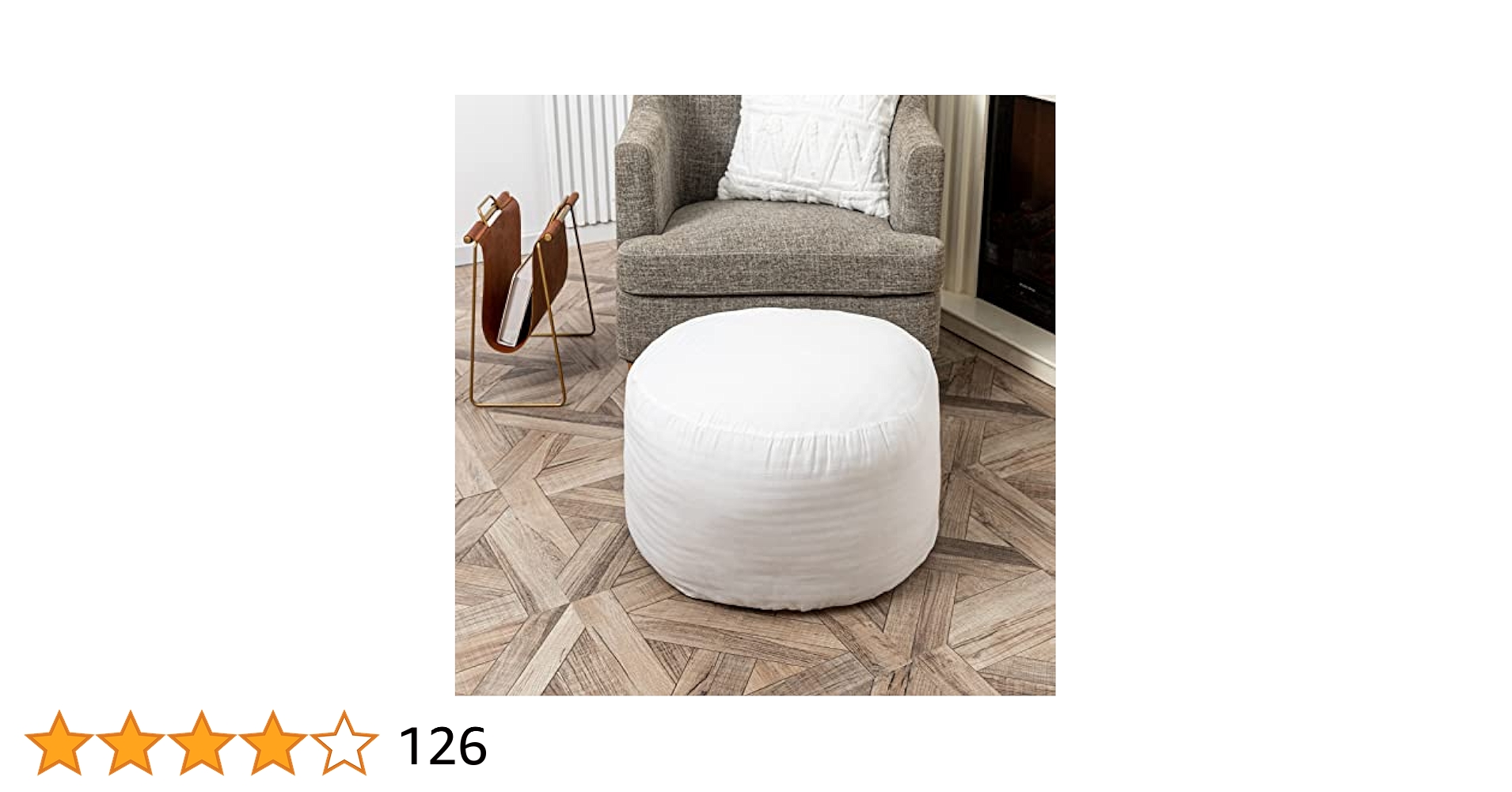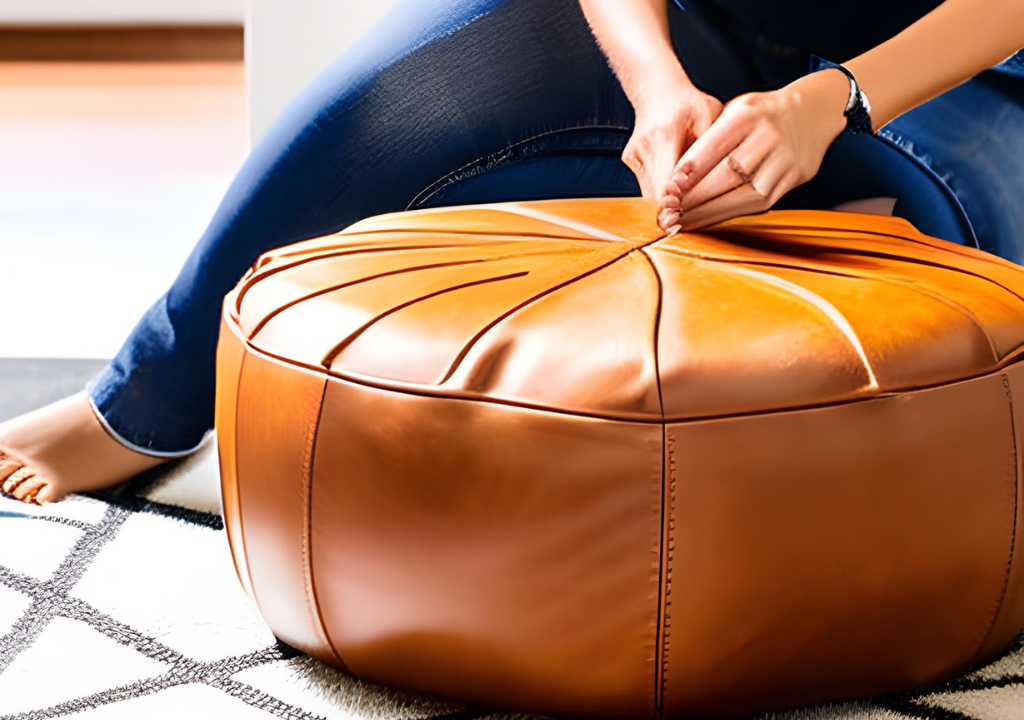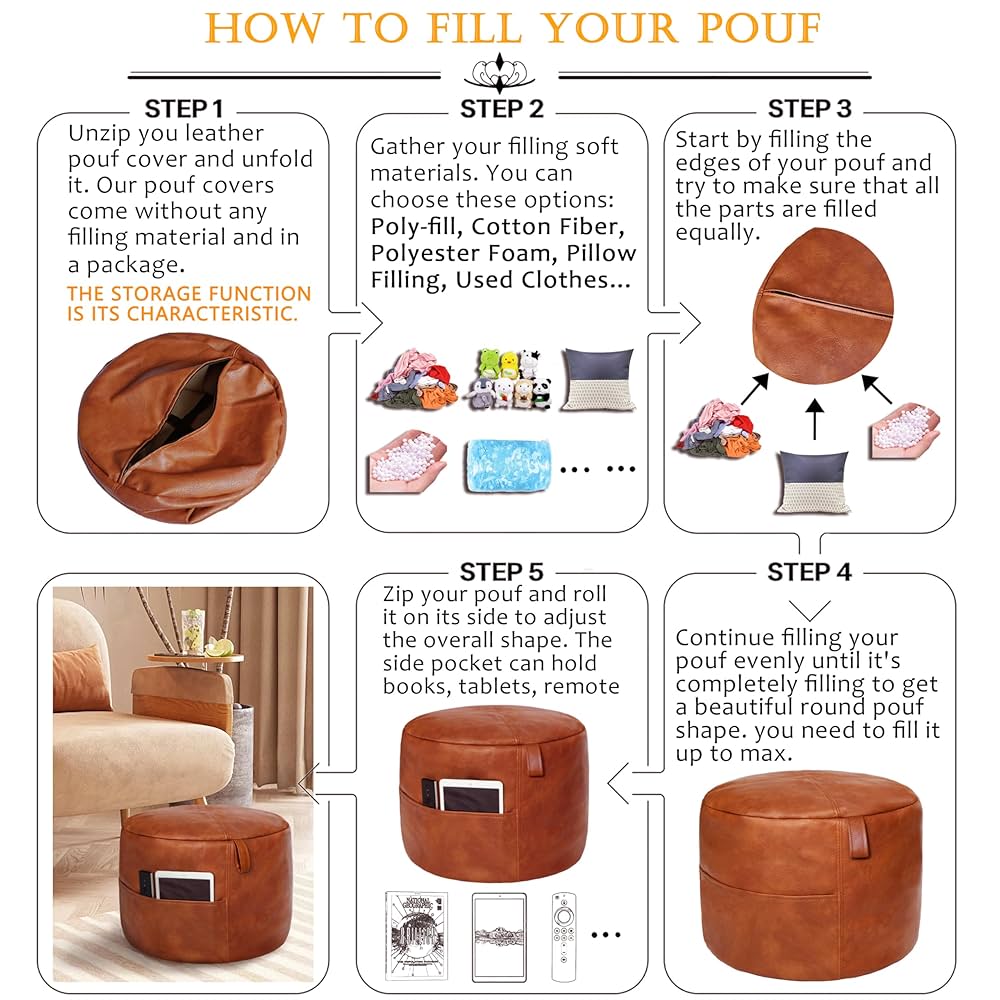Are you wondering what to use to fill your pouf for the perfect balance of comfort and style? Choosing the right filling can make all the difference in how your pouf looks, feels, and lasts.
Whether you want it soft and squishy or firm and supportive, the filling you pick will shape your experience every time you sit down. Keep reading, and you’ll discover the best options that fit your needs and budget—so your pouf becomes your favorite spot to relax.

Credit: www.frecklesandco.com
Choosing The Right Pouf Filling
Choosing the right filling for your pouf is important for comfort and style. The filling affects how the pouf feels and how long it lasts. Different fillings offer different levels of softness and support. Understanding these options helps you pick the best one for your needs.
Factors To Consider
Consider size and shape of the pouf. Think about where you will use it. Indoor or outdoor use changes the type of filling needed. Also, check if the filling is safe and non-toxic. Cost is another factor to keep in mind. Some fillings are more expensive but last longer.
Comfort And Support
Soft fillings like polyester fiber provide a plush feel. Foam fillings offer more support and keep shape well. Beans or beads give a flexible and lightweight option. Choose a filling that matches the comfort level you want. Test samples if possible to feel the difference.
Durability And Maintenance
Some fillings break down faster with use. Foam tends to last longer but can lose firmness over time. Beans and beads may compress and need refilling. Polyester fiber is easy to clean and maintain. Consider how often you want to replace or refill the pouf.

Credit: www.amazon.ca
Foam Fillings For Poufs
Foam fillings offer excellent support and comfort for poufs. They come in different types, each with unique features. Choosing the right foam affects the pouf’s durability and feel. Foam fillings can make a pouf soft, firm, or somewhere in between.
Memory Foam Benefits
Memory foam molds to the body shape, giving personalized comfort. It reduces pressure points and provides good support. This foam type keeps its shape well over time. Memory foam also absorbs movement, making poufs cozy for relaxing.
High-density Foam
High-density foam is firm and durable. It holds its shape for a long time without sagging. This foam is great for poufs used often. It provides a stable seat and strong support. High-density foam works well for both sitting and resting feet.
Shredded Foam Pros And Cons
Shredded foam is made of small foam pieces. It is soft and easy to shape inside the pouf. This filling allows good airflow, keeping the pouf cool. You can add or remove foam pieces to adjust firmness.
- Pros: Flexible, breathable, adjustable comfort.
- Cons: Can flatten over time, may need refilling.
Bean Bag Fillings
Bean bag fillings offer diverse options for customizing comfort. Choosing the right filling impacts the feel and durability of your pouf. Let’s explore the popular types of bean bag fillings.
Eps Beads
EPS beads are lightweight and affordable. They are made from expanded polystyrene, a type of plastic. These beads provide firm support and retain shape well. They are popular due to their durability. EPS beads are moisture-resistant, making them ideal for outdoor use.
Microbeads
Microbeads are tiny and smooth. They offer a silky texture, perfect for soft poufs. Made from plastic polymers, they conform to your body shape. This ensures comfort but may flatten over time. Frequent refilling keeps your pouf plump and cozy.
Natural Alternatives
Natural alternatives include materials like buckwheat hulls and kapok fiber. Buckwheat hulls provide firm support and are eco-friendly. They allow air circulation, keeping the pouf cool. Kapok fiber is soft and fluffy, offering a natural feel. It’s hypoallergenic and sustainable. These options are perfect for eco-conscious individuals.

Credit: medium.com
Natural Filling Materials
Choosing natural filling materials for your pouf adds a touch of eco-friendliness and comfort. These options often provide better breathability and durability compared to synthetic alternatives. Plus, they create a cozy feel that synthetic fillers sometimes lack.
Cotton And Wool
Cotton and wool are classic natural fillers known for their softness and resilience. Cotton is lightweight and breathable, making your pouf comfortable to sit on even during warmer months.
Wool, on the other hand, offers natural insulation and resists moisture, keeping the pouf fresh. Both materials compress well but bounce back, maintaining the pouf’s shape over time.
Buckwheat Hulls
Buckwheat hulls are small, hard outer shells of buckwheat seeds. They provide firm support and adjust easily to your body’s shape, which can make your pouf feel more supportive.
Many people prefer buckwheat hulls because they allow airflow, preventing heat buildup. However, they can be noisier when you move, which might be something to consider if you want a quieter seat.
Kapok Fibers
Kapok fibers come from the seed pods of the kapok tree and are incredibly light and fluffy. This natural material mimics the softness of down feathers but is vegan-friendly and hypoallergenic.
Kapok offers a plush and airy feel, making your pouf super comfortable for lounging. If you want a filling that is soft yet supportive, kapok could be the ideal choice.
Recycled And Eco-friendly Options
Choosing eco-friendly fillings for your pouf helps reduce waste and supports a greener planet. These options use recycled or natural materials that are kind to the environment. They offer comfort and durability while keeping sustainability in mind.
Recycled Foam Pieces
Recycled foam pieces come from discarded foam products like old cushions or mattresses. They get cleaned and shredded into small bits. This filling is soft, lightweight, and molds well to your body shape.
Using recycled foam reduces landfill waste and cuts down on new foam production. It provides good support and is often less expensive than new materials.
Eco-friendly Beads
Eco-friendly beads are made from biodegradable or recycled plastics. These beads offer a smooth, moldable texture that adjusts easily when you sit.
They are durable and maintain their shape over time. These beads break down faster in the environment than regular plastic beads.
Sustainable Natural Fillings
Natural fillings include materials like buckwheat hulls, cotton, or wool. These are renewable and compostable sources.
They provide firm support and good airflow inside the pouf. Natural fillings are less likely to cause allergies and are chemical-free.
Diy Pouf Filling Ideas
Filling a pouf yourself can be a fun and eco-friendly project. You have plenty of materials at hand that can turn into a comfy, stylish pouf. Choosing the right filling affects not only the comfort but also the durability and look of your pouf.
Using Old Clothes And Fabric Scraps
Old clothes and fabric scraps make excellent pouf fillers. They are soft, moldable, and easy to work with. Think about those worn-out t-shirts or leftover fabric pieces from past projects—you can cut them into small strips or balls and stuff your pouf.
This option helps you reuse materials that might otherwise end up in the trash. Plus, the pouf will have a cozy, cushioned feel that’s perfect for lounging. Have you checked your closet for clothes you no longer wear? It could be the perfect start!
Plastic Bottle Caps
Plastic bottle caps are a surprising but effective filler choice. They provide a firmer structure and make your pouf lightweight and easy to move around. Collect caps from soda or water bottles, rinse them well, and use them as a filling layer.
This filling is great if you want your pouf to hold its shape firmly. It also adds a bit of eco-consciousness by recycling plastic that would otherwise be waste. How many caps can you gather from your recycling bin?
Combination Fillings
Mixing different materials can give you the best of both worlds. For example, start with a base of plastic bottle caps for support, then add fabric scraps on top for softness. This approach lets you customize the firmness and comfort to your liking.
Try combining shredded foam with old clothes for a plush feel that still keeps its shape well. Experimenting with different textures can help you find the perfect balance for your pouf. What filling mix do you think would suit your space and style?
Tips For Filling And Maintaining Your Pouf
Filling and maintaining your pouf correctly can extend its life and keep it looking fresh. Choosing the right filling material is only part of the process; how you fill and care for it matters just as much. Small adjustments and regular upkeep can make your pouf comfortable and durable for years.
Filling Techniques
Start by selecting a filling that matches your comfort needs—foam beads for softness or shredded foam for firmer support. Use a funnel or a sturdy cardboard cone to fill the pouf evenly without making a mess. Don’t overfill; leaving some space allows the pouf to mold to your body.
Try layering different fillings to balance softness and structure. For example, add a base of foam beads and top with polyester fiberfill for a plush feel. Have you experimented with mixing fillings to find your perfect balance?
Refilling And Fluffing
Over time, your pouf will lose volume and shape. Check it every few months and add more filling if it feels flat. Fluff it up by shaking and kneading; this redistributes the filling and restores comfort.
Keep an eye out for lumps or clumping, especially with bead fillings. Breaking these apart with your hands or a rolling pin can refresh the pouf’s shape. How often do you find yourself needing to fluff your furniture?
Cleaning And Care
Protect your pouf by using a removable cover you can wash regularly. Spot clean the filling if it spills or gets dirty, but avoid soaking it, as moisture can cause mold. Air it out occasionally to keep it fresh and prevent odors.
If your pouf has a synthetic filling, vacuuming the surface can help remove dust and allergens. Avoid harsh chemicals that might damage the filling or fabric. What cleaning tricks have you tried that actually worked for your pouf?
Frequently Asked Questions
What Materials Work Best To Fill A Pouf?
The best pouf fillers include polystyrene beads, shredded foam, and polyester fiberfill. These materials offer comfort, durability, and maintain shape. Choose based on your pouf size and use, ensuring the filler is lightweight and easy to adjust or replace.
Can I Use Old Clothes To Fill A Pouf?
Yes, old clothes can fill a pouf as an eco-friendly option. Cut them into small pieces for better comfort and shape. This method recycles fabric and provides a soft, cushioned feel, though it may compress faster than synthetic fillers.
How Much Filler Is Needed For A Pouf?
Typically, a medium pouf requires 3 to 5 pounds of filler. The exact amount depends on pouf size and desired firmness. Start with less filler and add more until you achieve the perfect balance of comfort and support.
Are Foam Pieces Better Than Beads For Pouf Filling?
Foam pieces provide firmer support and don’t shift as much as beads. Beads offer lightweight, moldable comfort but may compress over time. Choose foam for durability and beads for a softer, more flexible pouf experience.
Conclusion
Choosing the right filler makes your pouf comfy and durable. Foam beads offer soft support and shape. Polyester fiber gives a fluffy, light feel. Old clothes or fabric scraps work well for a budget option. Consider size and use of the pouf before filling.
Fill it tightly for good shape, but not too hard. A well-filled pouf adds style and comfort to any room. Simple choices lead to great results. Enjoy your cozy, homemade pouf every day.





